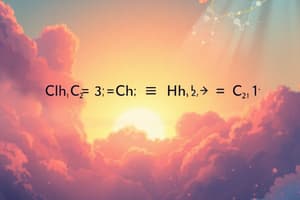Podcast
Questions and Answers
What is a chemical equation?
What is a chemical equation?
A chemical equation is a symbolic representation of a chemical reaction.
When is a chemical equation considered balanced?
When is a chemical equation considered balanced?
A chemical equation is balanced when the number of atoms of each element is equal on both sides of the equation.
Define 'reactants' and 'products' in a chemical equation.
Define 'reactants' and 'products' in a chemical equation.
'Reactants' are the substances that react to form new products, while 'products' are the substances formed as a result of the reaction.
What is a synthesis reaction?
What is a synthesis reaction?
Give an example of a decomposition reaction.
Give an example of a decomposition reaction.
Explain what happens in a neutralization reaction.
Explain what happens in a neutralization reaction.
What is the purpose of balancing a chemical equation?
What is the purpose of balancing a chemical equation?
Define stoichiometry in the context of chemical reactions.
Define stoichiometry in the context of chemical reactions.
What are redox reactions and how do they involve electron transfer?
What are redox reactions and how do they involve electron transfer?
How does temperature affect the rate of a chemical reaction?
How does temperature affect the rate of a chemical reaction?
What is the purpose of the rate law in chemical reactions?
What is the purpose of the rate law in chemical reactions?
How does electrolysis differ from corrosion in redox reactions?
How does electrolysis differ from corrosion in redox reactions?
Flashcards are hidden until you start studying
Study Notes
Chemical Reactions and Equations
A chemical reaction is a transformation in which substances change to become different substances. Reactions involve chemical bonds being formed or broken between atoms. In a chemical equation, the names of the substances appearing in pairs are called "reactants", while those appearing alone are called "products". A chemical equation is balanced when the coefficients, which are the numerical factors indicating the amounts of reactants and products, ensure that the number of atoms of each kind of element are equal on both sides of the equation, following the law of conservation of mass. This ensures that every chemical reaction involves the transference of atoms rather than the creation or destruction of them.
Types of Chemical Reactions
There are several types of chemical reactions, categorized according to the nature of the reactants and products:
- Synthesis: Formation of a new substance from simple substances. For instance, adding sulfur to diatomic sulfur produces polyatomic Sulfur.
- Decomposition: Breaking down of complex substances into simpler substances. For example, rust dissolves to produce Fe2+ ions and OH- ions.
- Neutralization: Two oppositely charged ions combine to neutralize each other. An example is the reaction of acids and bases.
- Double Displacement: Exchange of cations and anions between two compounds. For example, when calcium chloride and silver nitrate react, CaCl₂ and AgNO₃ exchange their ions to produce CaSO₄ and AgCl.
Balancing Chemical Equations
Balancing an equation means ensuring that the numbers of atoms on both sides of the equation match, so that the overall reaction obeys the law of conservation of mass. Coefficients are often needed to achieve a balanced equation because the real ratios of reactants to products are generally not whole numbers. An unbalanced equation can lead to incorrect calculations of the quantities of reactants and products.
Stoichiometry
Stoichiometry refers to the study of the chemical proportions of reactants and products. The stoichiometric factor indicates how to relate the individual chemicals in the reaction. From this information, one can predict the mass of products generated and, conversely, estimate the quantity of reactants required. For example, consider the combustion of glucose: [ C_6H_{12}O_6 + 6O_2 \rightarrow 6CO_2 + 6H_2O ] If an initial mass of glucose is burned, the balanced equation tells us that six times as much CO₂ and six times as much H₂O will be produced. Similarly, if you want to burn off all the glucose, you would need six times as much O₂.
Redox Reactions
Reduction–oxidation (redox) reactions are those in which electrons are transferred between chemical species. Oxidation adds electrons, while reduction removes them. Common redox reactions include burning, electrolysis, and corrosion. Electrolysis separates metals into their atoms through their compounds. Corrosion causes the surface of a metal to deteriorate due to chemical reactions with environmental agents, resulting in formation of salts and rust.
Reaction Rate
Reaction rate describes how quickly a reaction proceeds. Temperature affects the rate of a chemical reaction by increasing the kinetic energy of the particles (atoms and molecules), causing them to collide more frequently and with higher velocity. The rate of a reaction cannot be determined simply by looking at the equation; the actual speed depends on external conditions such as temperature. The rate law relates the reaction rate to the concentration of reactants raised to certain powers.
Studying That Suits You
Use AI to generate personalized quizzes and flashcards to suit your learning preferences.




